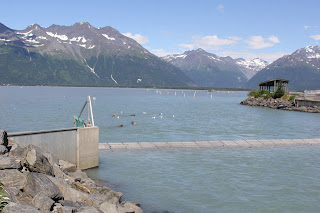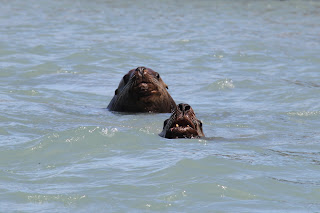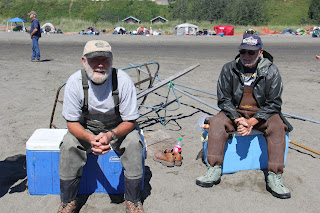 Deep in the heart of Prince William
Sound, surrounded by some of the world’s tallest coastal mountains is Valdez. It’s
why Valdez is called the Switzerland of Alaska. The city lies at
the head of Port Valdez, a natural fjord that reaches inland about 11 miles
from Prince William Sound. It is the largest port in all of Prince
William Sound and it’s an ice free port in winter. The population here is about
4,000. If you’re into fast food chains don’t come here. Valdez does have Thai,
Chinese and Mexican restaurants. Most of the businesses here are locally owned
and operated. The only national chain stores in town are the NAPA and
RadioShack stores.
Deep in the heart of Prince William
Sound, surrounded by some of the world’s tallest coastal mountains is Valdez. It’s
why Valdez is called the Switzerland of Alaska. The city lies at
the head of Port Valdez, a natural fjord that reaches inland about 11 miles
from Prince William Sound. It is the largest port in all of Prince
William Sound and it’s an ice free port in winter. The population here is about
4,000. If you’re into fast food chains don’t come here. Valdez does have Thai,
Chinese and Mexican restaurants. Most of the businesses here are locally owned
and operated. The only national chain stores in town are the NAPA and
RadioShack stores.
 This is the Solomon Gulch Fish Hatchery.
We’ve arrived at the beginning of the salmon run so there are only a few salmon
here. Further out in Prince William Sound there are hundreds of thousands of salmon
gathering, preparing to make a run to their home streams. Many of the salmon
will return here to the hatchery where they were born. Once they get here they
have to run the gauntlet of Stellar Sea Lions, Harbor Seals, bears and Bald
Eagles. See the five Sea Lions lurking in the brood pool waiting for the
salmon?
This is the Solomon Gulch Fish Hatchery.
We’ve arrived at the beginning of the salmon run so there are only a few salmon
here. Further out in Prince William Sound there are hundreds of thousands of salmon
gathering, preparing to make a run to their home streams. Many of the salmon
will return here to the hatchery where they were born. Once they get here they
have to run the gauntlet of Stellar Sea Lions, Harbor Seals, bears and Bald
Eagles. See the five Sea Lions lurking in the brood pool waiting for the
salmon?
 Once the Sea Lions catch a
salmon they toss it in the air, retrieve it, slap it on the water and then eat
it. All during this death ritual the Sea Gulls are right in there trying to
steal scraps from the mouths of the Sea Lions. While all this is going on you
see Seals slipping in and out of the brood pool trying to catch salmon without
becoming dinner for the Sea Lions!
Once the Sea Lions catch a
salmon they toss it in the air, retrieve it, slap it on the water and then eat
it. All during this death ritual the Sea Gulls are right in there trying to
steal scraps from the mouths of the Sea Lions. While all this is going on you
see Seals slipping in and out of the brood pool trying to catch salmon without
becoming dinner for the Sea Lions!
 The other cool thing about the hatchery
is all the Black Legged Kittiwakes who nest here. Parents take turns staying
with the chicks while the other one goes off to fish. A close look at the
Kittiwakes reveals most of these have two or three chicks under them. As you
can imagine, such close quarters leads to squabbles between neighbors. There
is always shrill screaming going on as birds fight for purchase on the ledge. I
wonder how the chicks keep from falling into the swift water below! As an avid
birder I could spend the whole day here just watching the birds. This photo were taken yesterday.
The other cool thing about the hatchery
is all the Black Legged Kittiwakes who nest here. Parents take turns staying
with the chicks while the other one goes off to fish. A close look at the
Kittiwakes reveals most of these have two or three chicks under them. As you
can imagine, such close quarters leads to squabbles between neighbors. There
is always shrill screaming going on as birds fight for purchase on the ledge. I
wonder how the chicks keep from falling into the swift water below! As an avid
birder I could spend the whole day here just watching the birds. This photo were taken yesterday.
 Today I went back to get more photos of the chicks and they were are all gone! No idea what happened, Fox? Ermine? There are so many predators here there is no telling who ate the chicks. The poor Kittiwakes have already started courtship rituals, nest rebuilding, fighting for mates, etc. I caught these two male Kittiwakes fighting over a female. They actually submerged in the river during the fight. I have to think the second batch of chicks won't fair much better. The wild kingdom is very cruel sometimes.
Today I went back to get more photos of the chicks and they were are all gone! No idea what happened, Fox? Ermine? There are so many predators here there is no telling who ate the chicks. The poor Kittiwakes have already started courtship rituals, nest rebuilding, fighting for mates, etc. I caught these two male Kittiwakes fighting over a female. They actually submerged in the river during the fight. I have to think the second batch of chicks won't fair much better. The wild kingdom is very cruel sometimes.
Today we visited The Maxine & Jesse Whitney Museum today. It contains one of the largest collections of Native Alaskan art and artifacts in the world. When the Whitney’s came to Alaska in 1947, they never imagined they’d end up staying for good. But stay they did, making a fresh start in a new land they soon called home. Maxine traveled to Native villages throughout the territory, buying items directly from the artists to sell in her gift shop. This is truly a world class museum filled with not only native art and artifacts, but also some amazing animal mounts. Polar Bears tower over visitors; huge wolves lounge around, while Elk, Caribou and Big Horn Sheep glare down at us. I really liked the scene with a pair of sled dogs pulling a seal on a sled. The expressions on the dog's faces are perfect! The large collection of Eskimo Dolls was really beautifully. Made me so glad I purchased Rosie in Inuvik!


Last time we were in Valdez we took a half day kayak trip on Lake Valdez
to see the Valdez Glacier. Feeling more confident in our kayak skills we took a
10 hour sea kayak trip to Columbia Glacier this time. The Columbia Glacier is 25 miles south of Valdez. The glacier
itself makes an amazing sight, encompassing 660 square miles flowing out of the
Chugach Mountains. It’s the second-largest tidewater glacier in North America
and the largest in Prince William Sound. The face is more than 3 miles wide and
it’s rapidly moving backward at a rate of 4 feet per day in the summer (and no
it’s not because of global warming!) At the foot of the glacier, hundreds of
small icebergs, known as growlers, have broken off the glacier and roll and
float in the Sound, many of them larger than a house! It was an iceberg from
the Columbia Glacier that led to Exxon Valdez Oil Spill.

We take a water taxi
out to Heather Bay and get dropped off at the glacier's terminal moraine. We have to portage our gear across the moraine and then everyone shoehorns their way into their kayak and buttons up. We
spend the day rowing around the sound enjoying the icebergs and the beautiful
scenery. There are loads of sea birds here, including Gulls and Murrelets.

I
have to admit I was a little worried about flipping over in the sea kayak and
being trapped by the spray skirt (you step into it and then it snaps around the
opening you sit in) while hanging upside down, trying to stay calm and waiting
to be rescued. But everything went just fine (WHEW.) Turns out it’s not easy to
flip the things.
 Later in the day we could hear icebergs breaking apart and
BOOMING into the water where we had been in the morning. The shapes and sizes of
Later in the day we could hear icebergs breaking apart and
BOOMING into the water where we had been in the morning. The shapes and sizes of
the icebergs was incredible. Some were as big as
a warehouse and some looked like ice sculptures. We had to gauge the height of the iceberg and then stay twice as far away as the iceberg was high. Apparently they not only break apart but they also flip over!
This is our fearless leader, Russell. He brought us hot cocoa, apple cider and chocolates for our break. We even got an Alaskan sex talk (seems the barnacles in the bay are sex maniacs.) The iceberg he's paddling in front of has flipped over creating the interesting shape.
Our sincere thanks to Anadyr Sea Kayaking for a another great trip. Our boat captain, Scott and our kayak guide Russell were awesome. I bet this trip will be the high light of our Alaska trip!

 On the 90 minute taxi trip to the
Columbia Glacier we passed the Valdez Fleet fishing for Pink Salmon. No gill
nets here just seine nets. To catch the salmon they use two boats. The large
boat carries the net and has the fish holding tanks. The second boat is much
smaller and is called a “Jitney.” It takes one end of the net and pulls it out
into the sound to make a circle. The end of the net goes back to the big boat
and then they begin hauling it in. Here’s the end result.
On the 90 minute taxi trip to the
Columbia Glacier we passed the Valdez Fleet fishing for Pink Salmon. No gill
nets here just seine nets. To catch the salmon they use two boats. The large
boat carries the net and has the fish holding tanks. The second boat is much
smaller and is called a “Jitney.” It takes one end of the net and pulls it out
into the sound to make a circle. The end of the net goes back to the big boat
and then they begin hauling it in. Here’s the end result.
This year Fish &
Game issued 230 commercial fishing permits for the Valdez Fleet. Once the
boat’s holding tanks are full they call for a tender to off load them. As fans
of The Deadliest Catch we were pleasantly surprised to see the Northwestern out
in the fjord offloading salmon to deliver to the processing plant in Valdez.
The next day the fleet came back to
Valdez to restock. They cleaned out Safeway. Want staples like bread or milk?
You’ll have to wait until the next Safeway delivery in three days. Here’s the
fleet getting ready to go back out. The harbor was completely crammed with
boats. They were moored six and seven deep. Lashed together like that the crews
had to cross from one boat, to another boat to another boat, etc.
The harbor was busting at the seams with commercial fishing boats!

Today Sherry and Jimmy took a Halibut fishing trip on the El Gat. They were gone from
6:30 am (yawn) until 6:00 pm. The boat carried them out to the Gulf of Alaska for some fishing in super deep waters. Sherry hooked a really nice Halibut. She was so excited about the fishing trip, she was like a kid in a candy store. I am pretty sure Jimmy went along to be sure Sherry didn’t fall over board in her excitement to catch a fish! Sherry’s biggest fish weighed 51.2 pounds. She and Jimmy also caught three Halibut in the 20 pound range. They're taking home 57 pounds of Halibut!



 Jim has a thing for chainsaw carvings so we stopped at a little place on the way back to Seward. This guy doesn’t use Redwood, he uses Spruce, which is much harder and has a finer grain. It allows him to carve much greater detail and put a much nicer finish on the carvings. I really liked his work, the proportions are more realistic. No funky, chunky bears and eagles like you see along the coast in Northern California. His carvings are unique, like the bear chairs – so cute! He said he lives in Port Angeles in Washington State. Every summer he loads up his wood and comes to Alaska to spend the summer carving. Check out his web site at thedreamerswoods.com
Jim has a thing for chainsaw carvings so we stopped at a little place on the way back to Seward. This guy doesn’t use Redwood, he uses Spruce, which is much harder and has a finer grain. It allows him to carve much greater detail and put a much nicer finish on the carvings. I really liked his work, the proportions are more realistic. No funky, chunky bears and eagles like you see along the coast in Northern California. His carvings are unique, like the bear chairs – so cute! He said he lives in Port Angeles in Washington State. Every summer he loads up his wood and comes to Alaska to spend the summer carving. Check out his web site at thedreamerswoods.com 
 We stopped at Kenai River Flats
so I could do a little birding. It was a warm and sunny day and the birding was awesome. Sherry and I
walked the road checking out all the little shore birds in the ponds. For great BBQ try Sackett’s in Cooper Landing. This was the best BBQ we’ve had in years!
Brisket, Pulled Pork and Hot Links. OMG, it was delicious.
We stopped at Kenai River Flats
so I could do a little birding. It was a warm and sunny day and the birding was awesome. Sherry and I
walked the road checking out all the little shore birds in the ponds. For great BBQ try Sackett’s in Cooper Landing. This was the best BBQ we’ve had in years!
Brisket, Pulled Pork and Hot Links. OMG, it was delicious. 














































